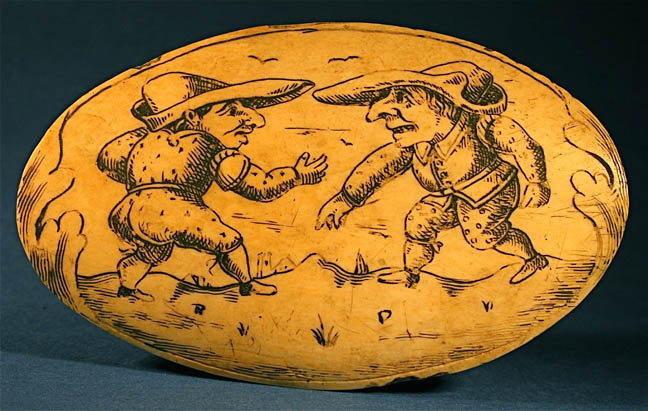

Title: Antique Ivory Engraved Scrimshaw European Wrestling Carving
Shipping: $65.00
Artist: N/A
Period: 17th Century
History: N/A
Origin: N/A
Condition: Museum Quality
Item Date: 1600 to 1700
Item ID: 4604
This is a "Unbelievable" European antique ivory carving. Looks to be a box top, it also could be German 17th 18th century. There are two wrestlers with big hats in the scrimshaw design. A box top from the European market of oval form decorated with two men fighting over something? It looks to have engraved monograms. In the Period In the form of two wrestlers. Hand carved ivory scrimshaw plaque top. Prospective purchasers are advised that several countries prohibit the importation of property containing materials from endangered species, including but not limited to coral, ivory and tortoiseshell. Accordingly, prospective purchasers should familiarize themselves with relevant customs regulations prior to buying if they intend to import this art into another country.
Link: http://en.wikipedia.org/wiki/Scrimshaw
Scrimshaw is the name given to handiwork created by whalers made from the byproducts of harvesting marine mammals. It is most commonly made out of the bones and teeth of sperm whales, the baleen of other whales, and the tusks of walruses. It takes the form of elaborate engravings in the form of pictures and lettering on the surface of the bone or tooth, with the engraving highlighted using a pigment, or, less often, small sculptures made from the same material. However the latter really fall into the categories of ivory carving, for all carved teeth and tusks, or bone carving. The making of scrimshaw began on whaling ships between 1745 to 1759 on the Pacific Ocean, and survived until the ban on commercial whaling. The practice survives as a hobby and as a trade for commercial artisans. A maker of scrimshaw is known as a scrimshander. Whale teeth and bones were a highly variable medium, used to produce both practical pieces, such as hand tools, toys and kitchen utensils, and highly decorative pieces, which were purely ornamental. The designs on the pieces varied greatly as well, though they often had whaling scenes on them. For example Herman Melville, in Moby-Dick, refers to "lively sketches of whales and whaling-scenes, graven by the fishermen themselves on Sperm Whale-teeth, or ladies' busks wrought out of the Right Whale-bone, and other skrimshander articles". Most engravings were adapted from books and papers.